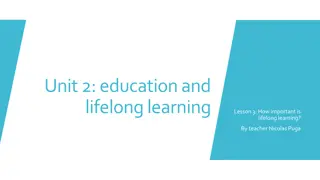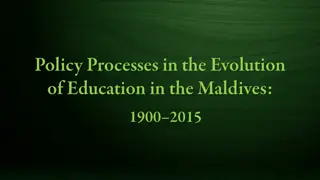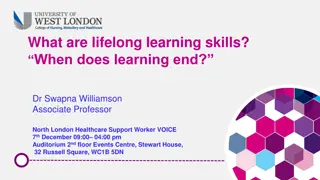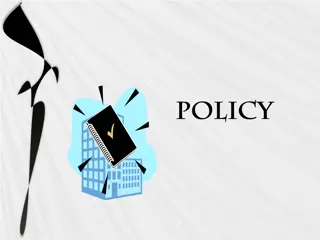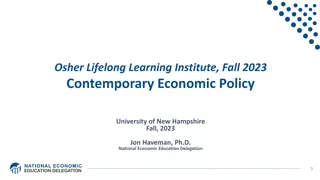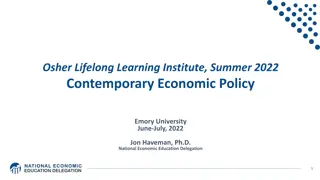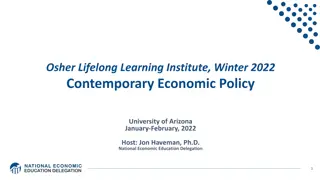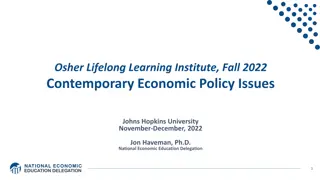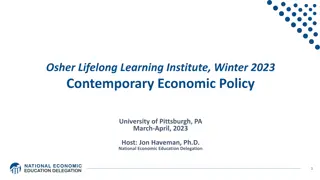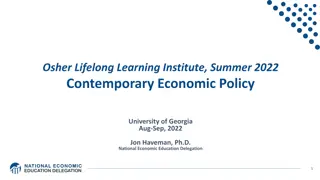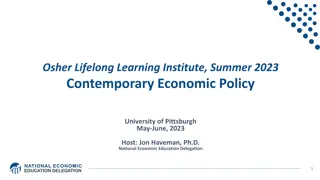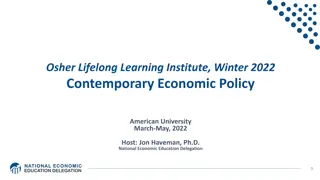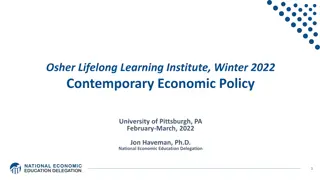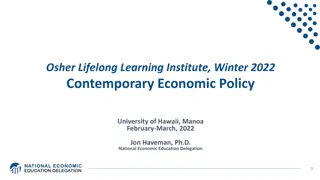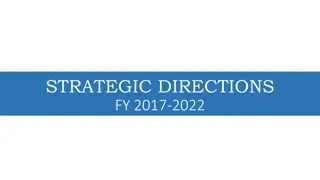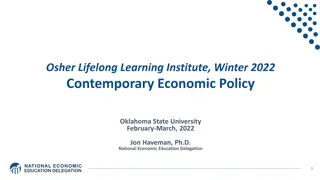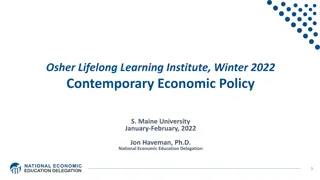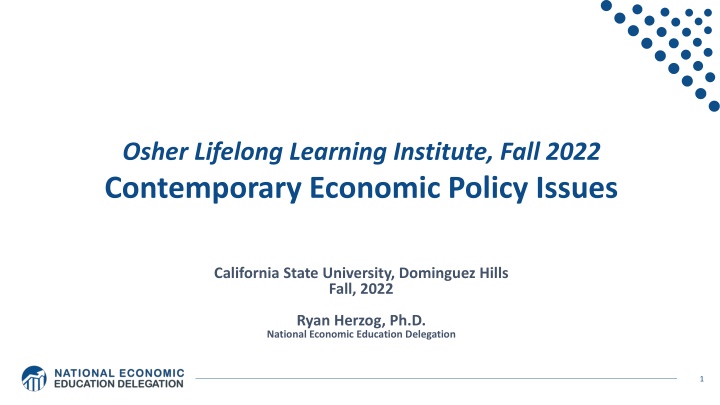
Contemporary Economic Policy Issues at Osher Lifelong Learning Institute
Dive into contemporary economic policy issues in California State University's fall 2022 course at the Osher Lifelong Learning Institute. Explore topics like economic inequality, trade, and more with expert instructors.
Download Presentation

Please find below an Image/Link to download the presentation.
The content on the website is provided AS IS for your information and personal use only. It may not be sold, licensed, or shared on other websites without obtaining consent from the author. If you encounter any issues during the download, it is possible that the publisher has removed the file from their server.
You are allowed to download the files provided on this website for personal or commercial use, subject to the condition that they are used lawfully. All files are the property of their respective owners.
The content on the website is provided AS IS for your information and personal use only. It may not be sold, licensed, or shared on other websites without obtaining consent from the author.
E N D
Presentation Transcript
Osher Lifelong Learning Institute, Fall 2022 Contemporary Economic Policy Issues California State University, Dominguez Hills Fall, 2022 Ryan Herzog, Ph.D. National Economic Education Delegation 1
Available NEED Topics Include: US Economy Immigration Economics Healthcare Economics Housing Policy Climate Change Federal Budgets Economic Inequality Federal Debt Economic Mobility Black-White Wealth Gap Trade and Globalization Autonomous Vehicles Minimum Wages US Social Policy 2
Course Outline Contemporary Economic Policy - Week 1 (9/19): Economic Update (Jon Haveman, NEED) - Week 2 (9/26): Trade and Globalization (Alan Deardorff, University of Michigan) - Week 3 (10/3): Cryptocurrencies (Geoffrey Woglom, Amherst College) - Week 4 (10/10): The Federal Debt (Ryan Herzog, Gonzaga University) - Week 5 (10/17): Economic Inequality (Ryan Herzog, Gonzaga University) - Week 6 (10/24): Trade Deficit and Exchange Rates (Alan Deardorff, Univ. of Michigan) 3
Submitting Questions Please submit questions of clarification in the chat. - I will try to handle them as they come up. We will do a verbal Q&A once the material has been presented. Slides will be available on NEED s website( www.NEEDelegation.org) 4
Economic Inequality Ryan Herzog, Ph.D. Gonzaga University OLLI-CSUDH October 17, 2022 5
Economic Inequality: Income Definition: - The extent to which the distribution of income deviates from complete equality - The dispersion of income throughout the economy 6
Different Ways of Thinking About Inequality Income Inequality - Before taxes and transfers - After taxes and transfers Wealth Inequality Consumption Inequality How does wealth differ from income? Income is measured over a period of time, say one year. Wealth is one s accumulated savings, including physical and financial assets (net worth). 7
Different Ways of Thinking About Inequality Inequality Inequality between groups How evenly income/wealth is divided across a population. Are there differences between different groups of people? It is about the distribution of some measure and not a comparison between sub-groups. Are observable outcomes different based on group characteristics? Ex: racial inequality or gender pay gap. 8
National Income Inequality: Share of Top 10% Stock Market Crash WWII Housing Bubble Dot-com Bubble 9
Recent Facts on Income Inequality Beginning in the 1970s, the income gap widened. - Income in the middle and lower parts of the distribution slowed - Incomes at the top continued to grow strongly - Income shares at the very top of the distribution rose to levels last seen more than 80 years ago 10 Source: Chad Stone, Danilo Trisi, Arloc Sherman, and Roderick Taylor, A Guide to Statistics on Historical Trends in Income Inequality, Center on Budget and Policy Priorities, Policy Futures, May 15, 2018.
An Abrupt Increase in Inequality 11 Source: Chad Stone, Danilo Trisi, Arloc Sherman, and Roderick Taylor, A Guide to Statistics on Historical Trends in Income Inequality, Center on Budget and Policy Priorities, Policy Futures, Dec. 11, 2018.
Gini Coefficient Gini coefficient a numerical measure that summarizes the overall dispersion of income - Ranges from 0 1 0 = perfect equality everyone has the same income 1 = perfect inequality one person has all the income - In practice: 0.5 0.7 highly unequal 0.2 0.35 relatively equal
Lorenz Curve of Income Distribution The greater the curvature of the Lorenz Curve, the greater is the degree of income inequality
US Income Distribution: 2015 Quintile Shares of Income CUMULATIVE Quintile Shares of Income 100 100 90 90 80 80 70 70 60 60 51.1 50 50 40 40 30 30 23.2 14.3 20 20 8.2 10 10 3.1 0 0 1 2 3 4 5 1 2 3 4 5 Income Quintiles Income Quintiles Source: 2015 1-year American Community Survey, based on pre-tax household income.
Income Share Changes Between 1970 and 2020 15 Source: U.S. Census Bureau, Current Population Survey, Annual Social and Economic Supplements.
Wealth Concentration Has Been Rising 2019 Overall Median: $121,700 18
Wealth is More and More Concentrated 99th Percentile 2016 = 7x 1963 19 Source: Urban Institute
Wealth Inequality Exceeds Income Inequality 20 Source: Chad Stone, Danilo Trisi, Arloc Sherman, and Roderick Taylor, A Guide to Statistics on Historical Trends in Income Inequality, Center on Budget and Policy Priorities, Policy Futures, Dec. 11, 2018.
Most of the Action Is at the Top: Pre-Tax Projected 2021 21 CBO: Projected Changes in the Distribution of Household Income, 2016 to 2021
Most of the Action Is at the Top: Post-Tax Projected 22 CBO: Projected Changes in the Distribution of Household Income, 2016 to 2021
Where Does Inequality Come From? Labor Characteristics - Demographics o Age distribution - Personal Choices o Educational attainment o Effort o Priorities o Household composition - Immigration Market Forces - Technology - Changing demand patterns - Competition for labor Government Policy - Market influence - Redistribution
Government Policy and Inequality Market Influence: PRE- distribution - Characteristics of labor o Access to education - Effects on labor demand o Market regulation Competition policy o Labor regulations Minimum wage, overtime, health insurance, etc. RE-distribution - Tax Rates - Income support o Direct aid o Food stamps 26
Tax and Transfer Programs and Inequality 2014 27 Source: U.S. Congressional Budget Office, The Distribution of Household Income, 2014 , Average Income Before and After Means-Tested Transfers and Federal Taxes, by Income Group, 2014.
What About Tax Rates? 1992-2014 +310% -12% Source: IRS, Statistics of Income Division, December 2016.
Dramatically Less Progressivity in the Tax Code 1961 to 2011 29 Source: New York Times, from Thomas Piketty, Emmanuel Saez and Gabriel Zucman, Distributional National Accounts: Methods and Estimates for the United States
Market Forces and Inequality Changing demand patterns - Technology - Globalization - Industry composition o PCs instead of typewriters o Services instead of goods o Professional services instead of personal services Competition in labor markets - Unionization - Market concentration 30
Where Does Inequality Come From? Summary Labor characteristics - What do workers bring to the market? Market forces - How does the market value the labor characteristics? Government policies - PRE-distribution affecting markets - Redistribution affecting incomes 31
Labor Income is Unhinged from Productivity Why? Declining unionization Globalization Immigration Competition policy Cheap technology
Declining Unionization Unionization Rates 1983: 2021: 20.1% 10.3% Unionization Rates Public: 33.9% Private: 6.1% 33 Source: https://inequality.org/facts/income-inequality/, Bureau of Labor Statistics and Emmanueul Saez, University of Califonria, Berkeley
Competition in the Economy Return on invested capital excluding goodwill US publicly-traded nonfinancial firms, 1965-2014 34 Source: Jason Furman, Forms and sources of inequality in the United States , VOX, March 17, 2016, Figure 6.
Growing Revenue Concentration 35 Source: The Hamilton Project, Brookings: The State of Competition and dynamism.
Technological Change and Inequality Much of the technology adopted in the last 30 years has eliminated low-skill or low-wage jobs. - Computers, advanced manufacturing equipment, steel mini-mills, automation There is a winner take all aspect of the technology-driven economy. - This likely favors a small group of individuals. Both aspects increase inequality by increasing the rewards to: - Those with significant labor market skills. - Owners over workers 36
Globalization What is globalization? - Flow of goods, services, capital, and labor across international borders How does it affect inequality? - Through a differential impact on low-skilled workers and hence their wages - For the United States, globalization is thought to lower the wages of low skilled and hence low-wage workers relative to those of high-skilled workers 37
Mechanisms for the Effects of Globalization Merchandise trade - Importing goods that are made with low-skilled workers and exporting goods that are made with high-skilled workers o Lowers the wages of unskilled relative to skilled making the distribution of income less equal Outsourcing - Similar channel as with merchandise trade Trade in services - US imports of middle-skill services: business and some professional services Intuitively: The same as if we were to move the actual workers. 38
Effects of the Unhinging? Labor s Share of Income 1960: 66% 2011: 56% 2016: 58% 39 Source: Bureau of Labor Statistics
Why Does Inequality Matter? Too little inequality can: - Reduce individual motivation - Slow economic growth Too much inequality can: - Reduce individual motivation - Slow economic growth Too much inequality may also: - Divide society - Distort political environment - Reduce political participation - Reduce investments in public goods o Education o Environmental protections
U.S. Racial Differences Odds of staying poor, if born poor Odds of becoming poor, if born rich 41 Economic Policy Institute, State of Working America, 2012
Government Policy and Racial Inequality Product of a long historical process of discrimination with at least two reinforcing sets of policies. - Policies that govern the spatial distribution of the Black population. o Restrictive covenants, redlining, and general housing and lending discrimination - Policies that have a disparate impact on Black individuals because of their locations. o The original version of Michigan Senate Bill 897 exempted individuals from this work requirement conditional on residing in a county with an unemployment rate above 8.5 percent. The higher unemployment rates in rural counties would disproportionately exempt white Medicaid recipients from the work requirement within the bill. 42
How Much Inequality Is too Much? Sweet Spot ? ? 100 0 Z X Gini Coefficient 43
Inequality Can Also Directly Affect GDP The US Economy is driven by consumption (67% of GDP). - Middle class are the big consumers. - They have less money. - Consumption is lower. - GDP is lower. 44
Too Much Inequality Can: Reduce work effort, which reduces GDP. Reduce purchasing power of the middle class, which reduces GDP. Reduce the ability of people to get ahead, which reduces mobility. - Puts the American Dream at risk. Increase the share of the population living on low incomes. - Offending our sense of equity? Desire for shared prosperity? Concentrate political power. 45
An International Perspective 46 Source: Data taken from the 2014 CIA World Factbook.
Addressing Inequality: Is It A Problem? Why it might be a problem. - Economic issues (Efficiency) o There is evidence that at some level, increased inequality slows economic growth. o Or, inequality concentrates resources among investors. - Noneconomic issues (Equity) o Values, ethics and morals will drive individual evaluations of the level of inequality. E.g., inequality is primarily a function of market outcomes, so should be left alone. Or, a solid middle class is important for maintaining a civil society, which runs contrary to a high degree of inequality. Suppose you think it s a problem. How might it be addressed? 47
Addressing Inequality: Immediately Available Policy Solutions (1/2) RE-distribution - Tax and transfer programs PRE-distribution - Strengthen labor unions - Collective bargaining - Other policies that favor labor over business owners - Minimum wages
Addressing Inequality: Immediately Available Policy Solutions (2/2) Other - Reverse trends in market power Locally - Employment services: job training, interview skills, or assistance with day-to- day issues, such as child care - Cognizance of the potential for technologies to affect worker/employer power dynamics o Uber, Lyft, etc.

